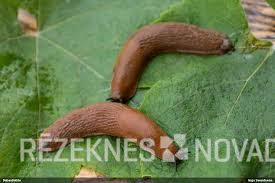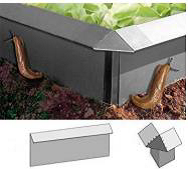Prevalence of Spanish catastrophic forests in Latvia and measures for restricting invasive species

Spain is one of the most important invasive animals and is ranked among the most invasive species in Europe. Spain's catastrophe meets the main criteria for invasive species: endangering natural habitats, breeding in the wild, causing genetic erosion of species of the genus Arion - naturally crossed with red fur (Arion Rufus).
For the first time in Latvia, the Spanish catastrophe was detected in 2009. Currently, this animal has already successfully spread to a large part of Latvia. Information that the residents of the municipality of Rezekne and the municipality of Rēzekne have reported two Spanish catastrophe deposits is available in the website of the Nature Protection Administration. By communicating with representatives of the Centre for Nature Research and Environmental Education of Daugavpils University, who currently carry out research on the spread of Spanish catastrophe, it was found that one of the deposits was approved in the Rēzekne forestry area in Rēznas Street, the second finding reported from the territory of the parish of Griškanas has not been approved.
In recent years there has been a rapid spread of this species, mainly due to the marketing of plants. Similarly, snail eggs from one place to another can be transferred to soil, compost, plant material. In areas where the species reproduces in most, it is characterised by mass populations, it takes its ecological niche and inhibits local animal species.
In the field of law, there are currently no laws and regulations on measures for restricting or combating Spain's casualties.
How to recognize?
The Spanish passageway reaches considerable sizes ranging from 7 to 14 cm long. Its body is massive and wide, slightly flattened. The colour is very variable, but it is most often brown-coloured. Sometimes some SPAs can be brownish, orange, or greyish, less black. The mucous membranes are mostly colourless, but they are usually yellowish or orange on the body surface. Non-adult specimens tend to have a dark band on both sides of the body, while the adult Kaylonian carcasses are monochrome.
The Spanish Kaylonian carcasses are night animals, their activity commenced in the evening by dusk, and continues until the morning. They are mainly fed with plants, but they are delighted with other invertebrates and specimens of their species, and there are even observations that they are destructed on the ground or near the surface of the birds nesting the surface of the ground. The day stays in hiding rooms, which can serve shadowy and damp areas in soil, compost piles, under planks, glasshots, bushes, sewerage wells and other objects. During the rain, the activity continues during the day.
Where is it?
In Latvia, the Spanish catastrophe has been detected in gardens, grassland, stops, roads, ditches, cemeteries etc. In certain places, the species is found in fields, water bodies and pastures. It is also found in forests, dunes and meadows.
Natural species prevalence corridors are roads, ditches and waterbodies in coastal areas where the number of naked forests is not restricted and the possibilities of their spread are not impaired. Bivalve molluscs do not interfere with human activities in a smooth area which serves as the centres for breeding and further spread.
In spring, by becoming warmer, molluscs become more active and begin to feed intensively. They feed and grow rapidly until the second half of the summer, when sexual maturation occurs and the eggs begin to spread. Molluscs live for one year, so the task of their lives is to leave as many offspring as possible. Egg laying may begin at the end of June and continue until December, depending on the time of winter. One specimen is capable of breaking up to 500 eggs during the summer season. The Spanish catastrophe does not only destroy plants but may also carry infectious disease agents, which may result in the occurrence of crops and livestock, and is a mediator for several parasite species that induce dogs and cats.
How do i limit this visit?
The fight with Spain's captive forests must be launched as soon as they are detected and remember that it will not be a one-off measure but a lasting and labour-intensive process. If we have detected a Spanish cascade in the territory of our property, this means that these animals are likely to be several and continue to multiply.
Methods of combating Spanish antimicrobial forests:
One of the simplest but very labour-intensive methods is manual harvesting of snails. This method could be effective if some specimens are detected in the area and the area is small. In general, the collection of catastrophic forests is practised early in the morning or evening when a period of activity begins in Spain's catastrophe forests and is still dew, or after the rain. The read molluscs are discarded in a container with a strong saline solution and drowned or mechanically separated by any sharp object. But it should be recalled that the uncollected mollusc residues attract live specimens that will be used for feed.
In the case of intensive reading, the number of flammable forests can be reduced to a density below a significant threshold.
Without reading, attention must also be paid to the mowing of the grass, as it also leaves the grass part of the shell. It should be recalled that the areas in which bivalve molluscs live should be used several times during the season, for example, with a one-off roadside or a ditch. The harvested grass should be collected and discarded along with shells. Ravēšana may also help to limit the spread of snails.
Catastrophe forests also be caught with the help of traps or hides. In wet and shadowy areas, a variety of objects, such as planks, jars, buckets, etc., are placed in close contact with the soil. A feed containing molluscs must be placed under the hiding place. It should be recalled that bivalve molluscs will only be used in these areas if there is enough humidity below them. If necessary, the traps should be filled with water. Shells are attracted by beer, blowing herbal residues, dead Kaylonian carcasses, feeding on the dry feed of cats and dogs, etc. It should only be recalled that the contents of the trap should be inspected on a regular basis and the slurry should be discarded by crushing and burying or burning. They must not be disposed of in compost.
Attention should be paid to soil treatment, in particular: soils in autumn . It will destroy the eggs of the Spanish catastrophe and also the adult specimens. The handling of the land is to be carried out directly in the autumn. Land discovery or cultivation will not be effective in this case.

Pilate D. et Al. 2018. Plan for limiting the species of Arion vulgaris (Moquin-Tandon, 1855). Daugavpils University, Daugavpils: 1-56
Plant holes can be protected by metal mushroomswhere the upper edge is deflected and represents an angle of 45 degrees, the mussels of such mushrooms cannot be overridden and gathered under the unfolded edge.
Alternatively, electric shepherds may be used to discourage molluscs with a voltage of 6-9 V, but at a voltage above 12 V, the Spanish Kaylonian carcasses are killed.
Bivalve molluscs natural enemies there are birds (sleeves, crow, crow, etc.). The Spanish snails do not have a lot of natural enemies, but they are known to feed badgers, wild pigs, hedgehogs and ducks.
In the fight against snails, poultry, especially domestic ducks, who are willing to read snails from the garden can also be used.
Methods of chemical control
You can try to create a chemical barrier: the bandwidth of the treated soil must be at least 3 metres, the technical salt, the coffee thicknesses can be used. Minus - Spain's naked body, in contact with the chemical irritant, releases a larger amount of mucous membranes that protect the mollusc body from exposure to the chemical, contaminated the soil with the substances that are used.
Chemical preparations, such as Ferramol, SLUXX, containing iron (III) phosphate, may also be used to protect their territory. Copper-vitriol (copper vitriol, Bordeo solution) is also used in the form of granules or solutions to the Spanish clay forests and is killed.
Disposal of harvested snails
If the shells are harvested by hand, they may be drowned in salt water, copper vitriol or copper sulphate solution, holding for at least 24 hours. They can be filled with hot water that will kill the snails. The collected dead specimens can be burned by feeding poultry or crushed and buried in soil.